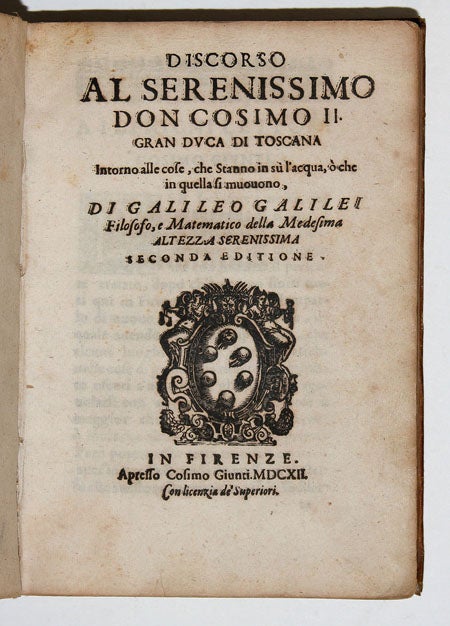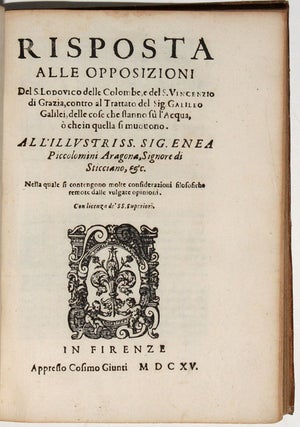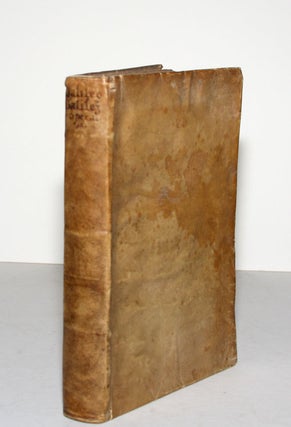Discorso al Serenissimo Don Cosimo II…Intorno alle cose, che Stanno in su l’acqua, o che in quella si muovono.
(2) ff, 77 pp, (1), (1) f with printer’s emblem.
Bound with:
[GALILEI, Galileo & CASTELLI, Benedetto]. Risposta alle Opposizioni del S. Lodovico delle Colombe, e del S. Vincenzo di Grazia... Florence, Cosimo Giunti, 1615. (1) ff, (2), 319 [ie 335] pp with numerous mispaginations, (5) including printer’s emblem. Bound in contemporary limp vellum with MS title on spine, “Galileo Galilei Opera’, internally very fresh, an excellent copy in all respects.
The second augmented edition of Galileo’s classic on hydrostatics, published the same year within months of the first edition, represents his first published work in physics (Drake, p. 179). The Discorso is hailed by historians of science as having united for the first time two previously separate disciplines: statics and dynamics, resulting in a new science of mechanics, containing his first published statements on the concept of moment, an abstract concept of physical force which has been shown to have dominated his early physical thinking, and contains several first announcements concerning some of his great astronomical discoveries relating to sunspots, the triple form of Saturn, and the phases of Venus. The present 2nd edition contains significant additional text concerning this important concept. The Risposta, one of the scarcest of Galileo’s works on the market, contains his lengthy and scathing replies to his critics only a year before his official castigation by the Catholic Church.
Two years after the publication of the Sidereus Nuncius which assured his place in the history of science, and after displaying his telescopic discoveries in Rome, Galileo returned to Florence and devoted himself to the study of floating bodies, “the real, intrinsic and total cause why some bodies float and others sink.” In the Discorso, Galileo supports Archimedes and opposes Aristotle on the behavior of bodies in water, arguing that the reason some solids sink is the excess of their weight over the weight of water. Employing the concept of moment— “the force with which the mover moves and the floating body resists” —and the principle of virtual velocities, Galileo far surpasses the hydrostatic considerations of Archimedes: “The new method enables Galileo to unify statics and dynamics into a new science of mechanics which became the foundation of modern physics” (Rose, The Italian Renaissance of Mathematics, p. 287).
As noted above, the second edition may be distinguished from the first by the additional material contained therein; notably, Galileo drew attention to these additions by printing them in Roman type rather than Italic. Among these additions are Galileo’s first announcements of the Sun’s rotation period, his announcements of sunspots, and his discovery of the “horns” of Saturn.
Predictably, Galileo’s opposition to Aristotelian physics earned him fierce criticism among natural scientists of his age. Three separate attacks were launched on the Discorso in the years following its publication, and Galileo was forced to defend his position or risk losing both the support of his patron, Grand Duke Cosimo II, and his scientific credibility at large. The present volume presents a fine example of the juxtaposition of both Galileo’s original doctrines and the Risposta to two of his critics, Vincenzo di Grazia and Lodovico delle Colombe.
Although he had previously ignored Colombe’s attack on his Sidereus nuncius, Galileo here takes up the gauntlet with a vengeance. Colombe had previously shown that while a sphere of ebony would sink in water, a thin piece would float – thus refuting Galileo’s theory of specific gravity on the very empirical grounds called for by the Ducal astronomer. Mocking Colombe mercilessly for parading this demonstration in public places rather than in print, Galileo dismisses him in his most biting and ad hominem style – “this text was written for those who know mathematics, and not for those who are totally ignorant in that discipline” (p 9).
“Colombe’s attack was answered in detail; the reply to di Grazia was confined mainly to correcting his logical errors and pointing out his misstatements concerning what Galileo had published. A section near the beginning touched on definitions, principle, and methods in science that may be outlined to throw light on Galileo’s approach… Di Grazia declared that all Galileo’s demonstrations were founded on false principles; Galileo replied that he had employed only two principles, both of which were omitted from his opponent’s listing; these were (1) that equal weights moved with equal speed are of like power in their effects, and (2) that greater heaviness of one body could be offset by greater speed of another” (Drake, p 220).
As he would do numerous times, Galileo hides behind the name of a devoted follower, Benedetto Castelli. However, a manuscript of the Risposta in Galileo’s own hand discovered in the Biblioteca Nazionale Centrale has convinced authorities such as Drake that it was, in fact, principally authored by Galileo himself. The importance of Galileo’s replies to the Aristotelians, and its place in the history and development of the scientific method, is encapsulated neatly in the following passage from the Risposta which makes clear Galileo’s break with ancient dogmatic authority:
“He [Galileo], without ever needing to resort to causes that are primary, secondary, instrumental, essential, accidental, related to figure, dryness, resistance of continuous mediums, fluidity, hardness, uncovered surfaces, antipathies, unctuosity, circumstances, qualified matters, skillful terms, and other hundred chimeras (that are your excuses), explains everything with only one simple and clear conclusion exempt from all those limitations and distinctions” (translated in Biagioli, p 192 n 104)
Note: the present copy of the Risposta contains two additional leaves completing the errata and giving the registration and printer's device, not recorded by Cinti – possibly suggesting the existence of several issues of this work, as with other publications by Galileo. These leaves are, however, found in many copies of the book.
* Cinti 35 & 51; Mario Baiagioli, Galileo Courtier.
Price: $48,000.00



